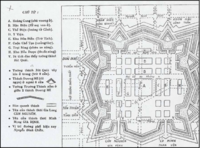Lê Văn Khôi revolt
| Lê Văn Khôi revolt | |||||||
|---|---|---|---|---|---|---|---|
| Part of Siamese–Vietnamese Wars | |||||||
 The French-built Citadel of Saigon was taken over by the rebels on 18 May 1833 and held more than two years until September 1835. |
|||||||
|
|||||||
| Belligerents | |||||||
|
Lê Văn Khôi rebels Supported by: |
|
||||||
| Commanders and leaders | |||||||
|
Lê Văn Khôi † Nguyen Van Tam † Le Van Cu Joseph Marchand |
Truong Minh Giang | ||||||
| Strength | |||||||
| Siamese troops and 2,000 Vietnamese Catholic troops | Unknown | ||||||
| Casualties and losses | |||||||
| 1,831 people were executed Only 6 survivors were temporarily spared |
Unknown | ||||||
The Lê Văn Khôi revolt (1833–1835) was an important revolt in 19th century Vietnam, in which southern Vietnamese, Vietnamese Catholics, French Catholic missionaries and Chinese settlers under the leadership of Lê Văn Khôi opposed the Imperial rule of Minh Mạng.
The revolt was spurred by the prosecutions launched by Minh Mạng against southern factions which had opposed his rule and tended to be favourable to Christianity. In particular, Minh Mạng prosecuted Lê Văn Duyệt, a former faithful general of Emperor Gia Long, who had opposed his enthronement. Since Lê Văn Duyệt had already died earlier in 1831, his tomb was profaned, and inscribed with the words "This is the place where the infamous Lê Văn Duyệt was punished".
Lê Văn Khôi, the adoptive son of general Lê Văn Duyệt, had also been imprisoned, but managed to escape on 10 May 1833. Soon, numerous people joined the revolt, in the desire to avenge Lê Văn Duyệt and challenge the legitimacy of the Nguyễn Dynasty.
Lê Văn Khôi declared himself in favour of the restoration of the line of Prince Cảnh, the original heir to Gia Long according to the rule of primogeniture, in the person of his remaining son An-hoa. This choice was designed to obtain the support of Catholic missionaries and Vietnamese Catholic, who had been supporting with Lê Văn Duyệt the line of Prince Cảnh. Lê Văn Khôi further promised to protect Catholicism.
On 18 May 1833, the rebels managed to take the Citadel of Saigon (Thanh Phien-an). Lê Văn Khôi was able to conquer six provinces of Gia Dinh in the span of one month. The main actors of the revolt were Vietnamese Christians and Chinese settlers who had been suffering from the rule of Minh Mạng.
As Minh Mạng raised an army to quell the rebellion, Lê Văn Khôi fortified himself into the Saigon fortress, and asked for the help of the Siamese.Rama III, king of Siam, accepted the offer and sent troops to attack the Vietnamese provinces of Ha-tien and An-giang and Vietnamese imperial forces in Laos and Cambodia. The Siamese troops were accompanied by 2,000 Vietnamese Catholic troops under the command of Father Nguyen Van Tam. These Siamo-Vietnamese forces were repelled in summer 1834 however by General Truong Minh Giang. Lê Văn Khôi died in 1834 during the siege and was succeeded by his 8-year-old son Le Van Cu.
...
Wikipedia
